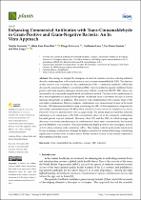Por favor, use este identificador para citar o enlazar este ítem:
https://repositorio.usj.es/handle/123456789/1147
Registro completo de metadatos
| Campo DC | Valor | Lengua/Idioma |
|---|---|---|
| dc.contributor.author | Ferrando, Natalia | - |
| dc.contributor.author | Pino Otín, Rosa | - |
| dc.contributor.author | Ballestero Fernández, Diego | - |
| dc.contributor.author | Lorca, Guillermo | - |
| dc.contributor.author | Terrado, Eva María | - |
| dc.contributor.author | Langa Morales, Elisa | - |
| dc.date.accessioned | 2024-03-18T09:22:40Z | - |
| dc.date.available | 2024-03-18T09:22:40Z | - |
| dc.date.issued | 2024-01-10 | - |
| dc.identifier.citation | Ferrando, N.; Pino-Otín, M.R.; Ballestero, D.; Lorca, G.; Terrado, E.M.; Langa, E. Enhancing Commercial Antibiotics with Trans-Cinnamaldehyde in Gram-Positive and Gram-Negative Bacteria: An In Vitro Approach. Plants 2024, 13, 192. https://doi.org/ 10.3390/plants13020192 | en_US |
| dc.identifier.issn | 2223-7747 | en_US |
| dc.identifier.uri | https://repositorio.usj.es/handle/123456789/1147 | - |
| dc.description.abstract | One strategy to mitigate the emergence of bacterial resistance involves reducing antibiotic doses by combining them with natural products, such as trans-cinnamaldehyde (CIN). The objective of this research was to identify in vitro combinations (CIN + commercial antibiotic (ABX)) that decrease the minimum inhibitory concentration (MIC) of seven antibiotics against 14 different Grampositive and Gram-negative pathogenic bacteria, most of them classified as ESKAPE. MIC values were measured for all compounds using the broth microdilution method. The effect of the combinations on these microorganisms was analyzed through the checkboard assay to determine the type of activity (synergy, antagonism, or addition). This analysis was complemented with a kinetic study of the synergistic combinations. Fifteen synergistic combinations were characterized for nine of the tested bacteria. CIN demonstrated effectiveness in reducing the MIC of chloramphenicol, streptomycin, amoxicillin, and erythromycin (94–98%) when tested on Serratia marcescens, Staphylococcus aureus, Pasteurella aerogenes, and Salmonella enterica, respectively. The kinetic study revealed that when the substances were tested alone at the MIC concentration observed in the synergistic combination, bacterial growth was not inhibited. However, when CIN and the ABX, for which synergy was observed, were tested simultaneously in combination at these same concentrations, the bacterial growth inhibition was complete. This demonstrates the highly potent in vitro synergistic activity of CIN when combined with commercial ABXs. This finding could be particularly beneficial in livestock farming, as this sector witnesses the highest quantities of antimicrobial usage, contributing significantly to antimicrobial resistance issues. Further research focused on this natural compound is thus warranted for this reason. | en_US |
| dc.format.extent | 21 | en_US |
| dc.format.mimetype | application/pdf | en_US |
| dc.language.iso | eng | en_US |
| dc.publisher | MDPI | en_US |
| dc.relation | The authors thank the financial support of the Gobierno de Aragón: Departamento de Ciencia, Universidad y Sociedad del Conocimiento (Group ECOBIOMED T67_23R), Cátedra NOVALTIA, and Universidad San Jorge. Natalia Ferrando thanks the Group IQE (Industrias Químicas del Ebro) for her predoctoral contract. | en_US |
| dc.rights | Atribución 4.0 Internacional | * |
| dc.rights.uri | http://creativecommons.org/licenses/by/4.0/ | * |
| dc.subject | Trans-cinnamaldehyde | en_US |
| dc.subject | Antibiotics | en_US |
| dc.subject | Synergy | en_US |
| dc.subject | MIC reduction | en_US |
| dc.title | Enhancing Commercial Antibiotics with Trans-Cinnamaldehyde in Gram-Positive and Gram-Negative Bacteria: An In Vitro Approach | en_US |
| dc.type | info:eu-repo/semantics/article | en_US |
| dc.identifier.doi | https://doi.org/ 10.3390/plants13020192 | en_US |
| dc.rights.accessrights | info:eu-repo/semantics/openAccess | en_US |
| Aparece en las colecciones: | Artículos de revistas | |
Ficheros en este ítem:
| Fichero | Descripción | Tamaño | Formato | |
|---|---|---|---|---|
| Enhancing Commercial Antibiotics with Trans-Cinnamaldehyde.pdf | 570,4 kB | Adobe PDF |  Visualizar/Abrir |
Este ítem está sujeto a una licencia Creative Commons Licencia Creative Commons

